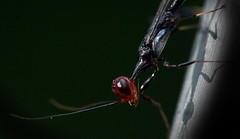[mbs slideshow=1]
[caption id="" align="alignleft" width="240" caption="Life: Kingdom: Metazoa (animals); Phylum: Arthropoda; Class: Hexapoda; Order: Hymenoptera; Superfamily: Stephanioidea; Family: Stephanidae; Subfamily: Stephaninae) Genus : Foenatopus. "]
 [/caption]
[/caption]I am always intrigue by the forms, curves, contours and the colours of Wasps. We are less familiar with them, except fearing them and categorising them with the venomous Asian Giant Hornets that sting human.
My first encounter was with the genus Foenatopus belonging to the family Stephanidae at the Singapore Kent Ridge Park. It is considered a primitive family. Shuh Fang spotted her perching on the stainless steel signboard. Her length was between 1.2cm and 1.5cm. I took some shot at about a foot away, fearing that she might sting me if I annoyed her. She was all metallic and reflective; every bit of her elongated body was exuding precision, signalling power and awe. Her reddish brown spherical head connected to a slim neck before the thorax, tapered into the abdomen and ending with a long ovipositor. She looked every bit a killing machine. The legs at the femur and tibia were sculptural muscular forms terminating with the needle-like tarsus.
[caption id="" align="alignleft" width="240" caption="The long ovipositor is impressive. It is as long as the abdomen, the thorax and the head."]
 [/caption]
[/caption]Her form is truly amazing. I had only a single aim, to capture her portrait as close as possible. I fear the needle like stink that protrude from her posterior, which I later learned was an ovipositor. I wanted to record her beauty. All that fear dissolved in the singular quest and the excitement within me. Without realising, my lens hood was less than 5 cm from her that was as far as the 100mm could focus. I became the Insecthunter, hunting that illusive micro world, immersing in its magic and micro- reality, holding every breath and freezing every movement before I depressed my index finger. Sweat soon streamed down my face, eyelids, nostrils and fog soon gathered on my glasses.
The reflection off the stainless steel surface created a nice shine beneath her. Fortunately I had captured her grandeur before a group of inquisitive students came and alerted her. She took flight, flying directly into another bush and disappeared.
[caption id="" align="alignleft" width="400" caption="Garden Wasp"]
 [/caption]
[/caption]If we can appreciate the beauty of the female nude, we should be able to appreciate the wondrous forms of this Wasp. These common garden wasps are found in low shrubs and on tree bark gathering wood globules, possibly for making their nests. I was impressed by its slender orangey petiole; its abdomen consists of two parts, the upper portion, in deep dark blue shape like a cup, covered over the petal of curved pinkish lower portion. The light was low and I set the ISO to 1600, some noise is noticeable on the photograph.
[caption id="" align="alignright" width="240" caption="Handicapped wasp"]
 [/caption]
[/caption]Their lives are always perilous, everyday danger lurks in some corner of the earth. This wasp had lost its foreleg, but it was still toiling using the remainder of its other legs with its mandibles picking up wood globules, without apparent grief or despair. If only we human could learn from him to face life as a natural process even when we are handicapped, life would be liveable and wonderful. We should feel exhilarated with every breath we take!
At one instant they are the victims and at another they are the fierce predators that hunt down their preys to keep themselves alive.
Thanks omeuceu, evanioidea and Matt for the ID
omeuceu "ok. I was right about the family: it is Stephanidae. The genus is: Foenatopus (=Diastephanus) . The genus was IDed by a specialist, not myself. I just pointed the family. ;)" Matt Bertone
"is a wasp in the family Stephaniidae. They are among the most basal ("primitive") of the parasitic wasps." From evanioidea, the wasp specialist, "That is definitely a stephanid wasp (Stephanidae). We don't know yet for sure, but many hymenopterists believe that this is the sister to the thread waisted wasps (Apocrita). In many ways this group of wasps bridges the gap between sawflies and apocritans. Very cool picture. Those wasps are rarely seen!"
I collaborated with Gigi Wang and Zhou Yan in Flickr. They helped to add short Chinese prose to the photographs which inspired them. It was my first collaboration with Chinese writers. In 2006, I held a small exhibition at the National Univarsity of Singapore's Central Library.
Thanks Alec for reading through this article and giving me his valuable advise.

Wow! the Foenatopus resembles a mean machine crafted out of titanium. amazing beauty. Great stuff!
ReplyDeleteYes, I was rather careful not to be stung by the Foenatopus. Glad that you drop by to have a look.
ReplyDelete